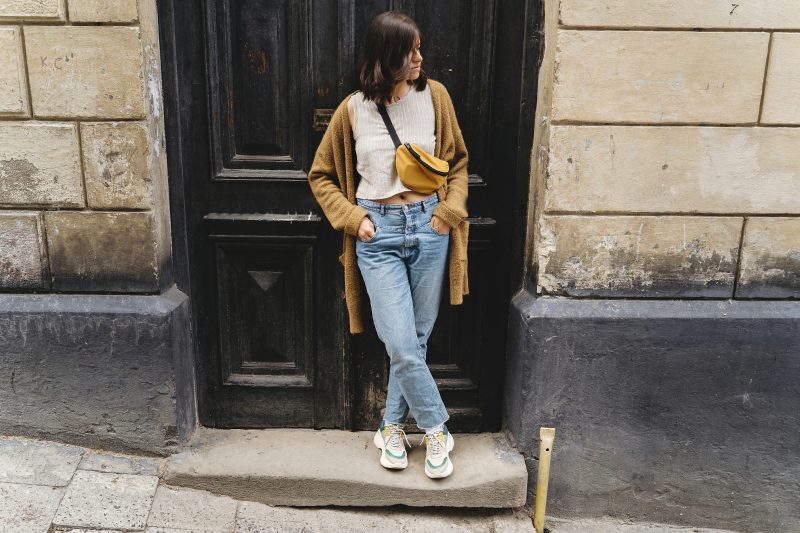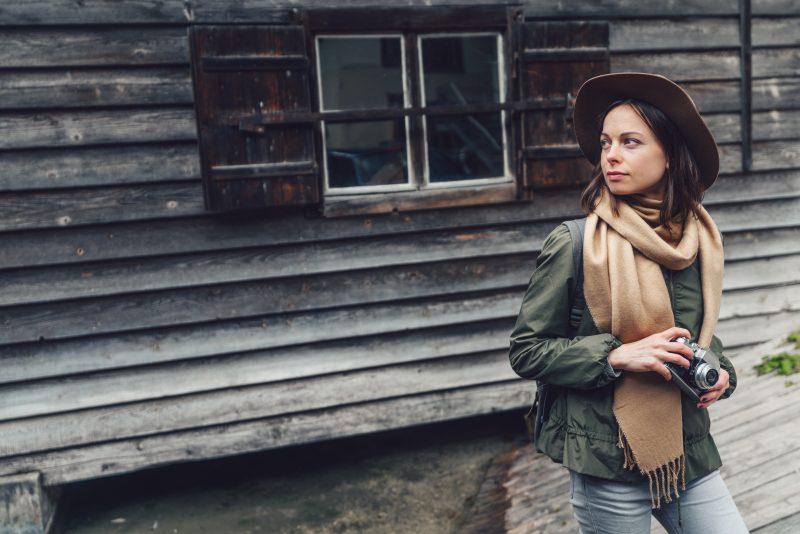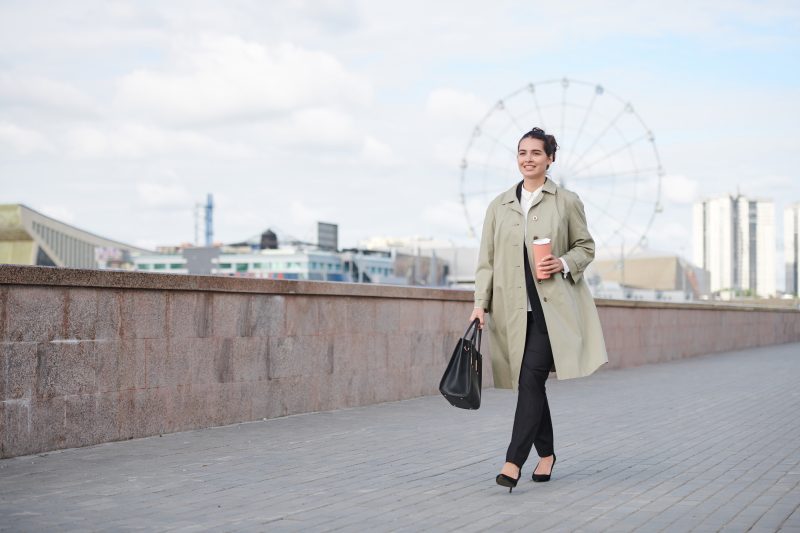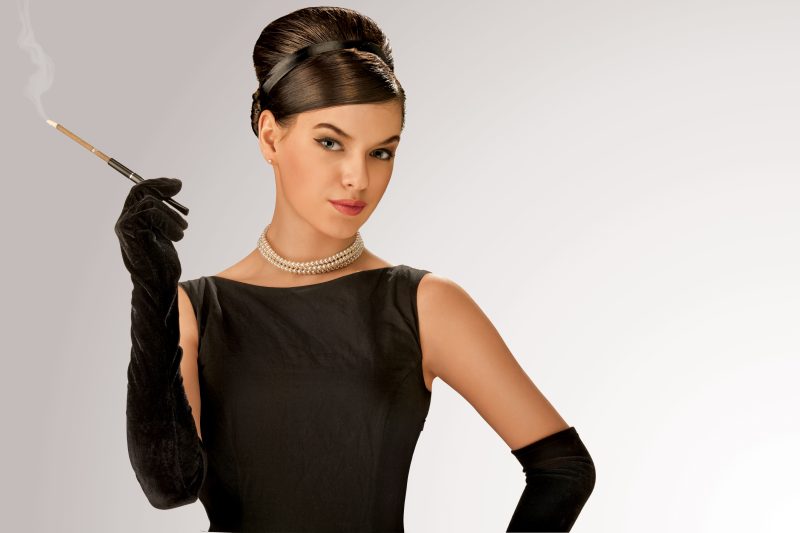I first noticed it on a Tuesday morning, bleary-eyed and doomscrolling through Instagram before my alarm had even finished its first snooze cycle. There it was—a perfectly ordinary outfit (straight-leg jeans, white tank, black blazer) transformed into something that made me actually sit up in bed and squint at my screen. The difference wasn’t the clothing itself, which was baseline wardrobe staple territory, but a styling detail so simple yet effective that I immediately felt both impressed and slightly irritated I hadn’t thought of it myself.
The trick? A visible bra strap. Not just any visible bra strap, mind you, but a deliberately styled, contrast-colored, sometimes logoed lingerie strap peeking out from beneath tank tops, slip dresses, and off-shoulder sweaters.
The kind of thing that my mother spent my entire adolescence tucking back under my shirts with a disapproving tsk while muttering about “looking unkempt.”
But this wasn’t your accidental Victoria’s Secret strap slippage circa 2004. This was calculated, editorial, and somehow making otherwise completely basic outfits look exponentially more interesting. It was also, as I quickly discovered when I fell down a rabbit hole of comment sections, wildly divisive.
“This is so tacky, I can’t even,” wrote one commenter under a fashion influencer’s post featuring a crisp white button-down with a black lace bralette deliberately visible beneath.
“LOVE this styling, genius touch that makes everything look cooler,” countered another.
“We’re really calling visible undergarments a ‘styling trick’ now? My grandmother is rolling in her grave,” commented a third, triggering an entire debate about generational attitudes toward visible lingerie.

My interest was piqued, not just as someone who writes about fashion for a living, but as someone who has approximately 47 white tanks and black blazers in her closet and is perpetually looking for ways to make these staples feel fresh without buying yet another version of essentially the same thing (my accountant thanks you, styling innovations).
The following Saturday, I conducted an experiment at brunch with Emma, my most brutally honest friend and the human equivalent of those savage red pen marks your high school English teacher would make on essays.
I wore my standard weekend uniform—vintage Levi’s, a slightly oversized white tank, and a black oversized blazer I’d splurged on during the Net-a-Porter sale last year. Standard issue fashion editor off-duty attire, nothing remarkable. But before leaving my apartment, I deliberately styled a black Eres bra strap to be visible against my left shoulder, contrasting with the white tank. The strap itself was substantial enough to read as intentional rather than accidental.
Emma noticed immediately. “Is your bra showing on purpose, or do you want me to tell you about it?” she asked within thirty seconds of sitting down, reaching for the cocktail menu without looking up. This is why I love her.
“It’s intentional,” I said, trying to sound casual while also adjusting the strap to make sure it was still visible at what I hoped was an aesthetically pleasing angle. “It’s a thing now. All over social.”
Emma studied me over her menu, eyebrow raised in that way that always makes me feel like I’m being carbon-dated for uncoolness. “Huh,” she finally said. “It actually works. Makes the whole basic outfit thing look more… considered.”
Coming from Emma, this was the equivalent of a standing ovation. I relaxed and ordered a Bloody Mary, feeling validated.
The true test came when we left brunch and wandered through SoHo, that outdoor runway of weekend fashion peacocking. I counted no fewer than seventeen compliments or inquiries about my outfit—not a single one of which mentioned the visible bra strap directly, but all of which indicated that something about the look was registering as stylistically interesting.
“Love your whole vibe,” said the salesgirl at Aritzia, gesturing vaguely toward my upper body.
“Where’s your blazer from? The way you’ve styled it is so good,” asked a tourist who stopped me to ask for directions to the Glossier store.
Even more telling were the number of subtle strap adjustments I noticed on women we passed after they clocked my look. The visible strap was having a ripple effect in real time.
Back at home, I dove deeper into this emerging trend, trying to understand exactly why something so simple was creating such an impact—and such division in the comments.
The fashion mathematics of it are actually pretty straightforward. Basic outfits—your standard jeans and tee, slip dress, button-down and trousers—tend to present as a unified visual plane. They’re clean, uncomplicated, and precisely because of that, can sometimes read as underwhelming despite being technically “correct.” The visible bra strap introduces an intentional disruption to that visual plane. It’s a controlled bit of dishevelment, a deliberate imperfection that signals intention.
It’s also, not coincidentally, a styling trick that costs exactly zero dollars if you already own undergarments, making it accessible in a way that many trend cycles aren’t. You don’t need to buy the new It bag or invest in whatever Y2K revival piece is currently commanding outrageous resale prices. You just need to not tuck in your strap—though, as I quickly learned, there’s an art to exactly how you don’t tuck it in.
The most effective execution of the visible strap trend isn’t actually about showing as much lingerie as possible (that’s a different aesthetic entirely). It’s about the strategic reveal—one strap asymmetrically placed to create visual interest, or a specific color contrast that pulls together other elements in your outfit. Black straps with white tops create sharp definition; colored straps can coordinate with accessories or other subtle details in your look; logoed straps… well, they make it abundantly clear you’re doing this on purpose and not just bad at dressing yourself.
But what about the controversy? Why were comment sections so divided over something relatively minor in the grand scheme of fashion boundary-pushing?
I posed this question to Katherine Wang, my editor-in-chief, during an editorial meeting. Katherine, who came up through fashion in the early 2000s and experienced the first wave of visible straps (though those were far less intentional and more the result of early aughts fashion’s general chaotic approach to coverage), had an interesting perspective.
“It’s controversial precisely because it’s playing with something that has traditionally signaled a mistake,” she explained, adjusting her perfectly structured Khaite blazer that would never dream of revealing anything as uncouth as an undergarment. “Older generations were taught that visible lingerie meant you weren’t properly dressed. Younger consumers see it as a styling opportunity. The tension between those viewpoints is where trends often emerge.”
She’s not wrong. Fashion’s most interesting moments often happen at precisely these friction points between propriety and rebellion, between concealment and revelation. The visible bra strap sits in that perfect sweet spot—just transgressive enough to feel modern while not being so extreme as to be unwearable in most contexts.
To better understand the divisiveness, I conducted a highly unscientific Instagram poll from my personal account. The results were fascinating. Of followers over 40, only 23% approved of the visible strap trend. For those under 30, approval shot up to 78%. The 30-40 demographic was almost perfectly split down the middle.
The comments were even more revealing (pun fully intended):
“I spent years being dress-coded for visible straps in high school, so seeing this celebrated as fashion feels like vindication,” wrote one follower in her mid-twenties.
“There’s a difference between messy and stylized imperfection. This is the latter and it works,” commented a 35-year-old fashion buyer.
“This isn’t a ‘trick,’ it’s just looking like you got dressed in the dark,” countered a 52-year-old who identified herself as “a real adult with a corporate job.”
That last comment sparked an entire sub-thread about workwear appropriateness, generational divides in professional dress codes, and whether visible lingerie elements would ever be acceptable in corporate environments. The consensus seemed to be that certain industries (tech, creative fields, anything in Los Angeles basically) were more open to this styling approach than others (law, finance, anything in the Midwest apparently).
Intrigued by these divisions, I decided to take the experiment further and test the visible strap styling in different contexts throughout a full week. The results were illuminating.
Day 1: Editorial meeting at Style Compass USA. Outfit: Black slip dress with deliberately visible emerald green bra straps. Reception: Universally positive from the fashion team, with three people actually taking pictures “for reference.” Katherine merely raised an eyebrow but later referenced the look as “editorially interesting” which in Katherine-speak is essentially a rave review.
Day 2: Coffee with a potential advertiser, a luxury skincare brand with conservative branding. Outfit: Cream pantsuit with a silk camisole and visible black lace strap on one shoulder only. Reception: The brand manager, a woman in her early forties, initially seemed slightly confused by the visible strap but ultimately complimented my “attention to detail.” Contract pending, so calling this one a qualified success.
Day 3: Dinner with my parents at their country club in Connecticut. Outfit: Navy blue sheath dress with a visible navy bra strap matched to look nearly seamless but still detectably present. Reception: My mother adjusted my strap under the table within 90 seconds of seeing me and whispered “You forgot to fix your dress” with genuine concern for my apparent wardrobe oversight. When I explained it was deliberate, she looked at me with the same expression she had when I dyed my hair blue in college. The club’s maître d’ called me “miss” all night despite having known me for 15 years. Definite failure.
Day 4: Industry panel about sustainable fashion practices. Outfit: Oversized white button-down with visible black bralette straps and a hint of the bralette’s lace edge at the deeper neckline. Reception: Mixed. Two panelists (both under 35) incorporated similar styling into their own outfits at our next industry event. One senior executive (male, 60s) asked if I was “planning to finish getting dressed after the panel.” The moderator (female, 40s) didn’t comment verbally but adjusted her own blazer to ensure no hint of undergarment was visible from her outfit. Draw.
Day 5: First date with an architect I’d met through friends. Outfit: Off-shoulder knit sweater with deliberately asymmetrical placement showing one burgundy bra strap. Reception: He didn’t seem to notice or comment on it specifically, but did mention he liked my “whole aesthetic” and we have a second date scheduled, so categorizing this as a non-issue verging on positive.
The pattern was clear: context and audience matter enormously in how this styling detail is received. In fashion-forward environments, the visible strap reads as intentional and stylistically astute. In more traditional settings, it remains firmly coded as a mistake or an oversight. The generational divide is real, with millennials and Gen Z generally viewing it as a legitimate styling option while Boomers and most Gen X observers interpret it as an error in need of correction.
But here’s the really interesting part—even in contexts where the visible strap wasn’t overtly appreciated, it still succeeded in making otherwise basic outfits more memorable. My navy dress at the country club was a perfectly ordinary garment, something that would normally register as appropriate but forgettable. The visible strap, even though it was received negatively by that specific audience, made the outfit register. People noticed. The styling detail created impression and memory, even if that impression wasn’t universally positive.
And therein lies the actual power of this controversial styling trick: it transforms passive dressing into active statement-making. It takes clothing choices from the realm of the correct into the realm of the considered. That slight disruption—the deliberate imperfection—signals intention and thought.
It’s not actually about the lingerie itself. It’s about the metacommunication of deliberate choice. It’s saying “I considered all the rules of proper dressing and chose to break this particular one in this particular way,” which paradoxically demonstrates greater mastery of fashion rules than simply following them all would.
For those interested in experimenting with this trend but concerned about negative reception, I’ve developed a sliding scale of strap visibility that might help navigate different contexts:
Entry level: Tone-on-tone matching (black strap with black top) creates subtle texture difference without stark contrast.

Intermediate: Complementary color straps that coordinate with another accessory in your outfit, creating a purposeful color story.
Advanced: Contrast straps that create deliberate tension with your main garment, the most obvious execution of the trend.
Expert: Designer or logo straps that remove all doubt about intentionality and transform the undergarment into an accessory in its own right.
As with most controversial trends, the visible strap moment will eventually evolve or fade.
Fashion’s pendulum swings constantly between concealment and revelation, between structure and dishevelment. What makes this particular styling detail interesting is its simplicity and accessibility—it doesn’t require new purchases or rarified body types or special knowledge.
It simply asks you to reconsider something you’ve been told is “wrong” and examine whether, in the right context, that wrongness might actually be exactly right. That questioning of established rules—the transformation of mistakes into choices—is where personal style truly develops.
Just maybe don’t try it at your next country club dinner with parents. Some battlefield testing is best left to fashion professionals.



